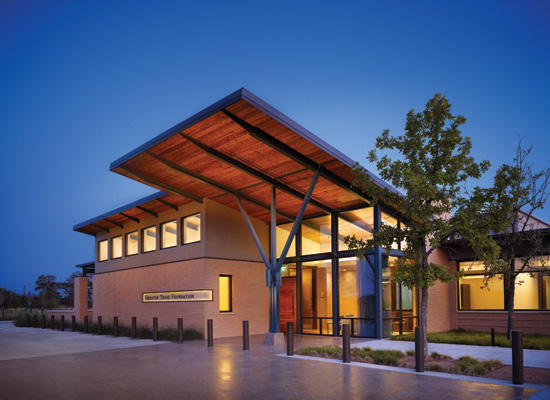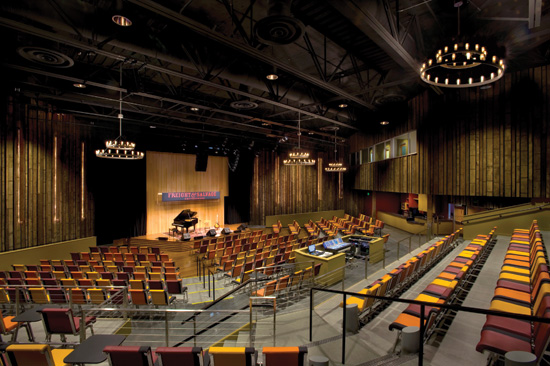Wood and Indoor Environment
Reclaimed Wood
In contrast to other materials, wood can typically be reclaimed and reused at the end of its service life, with only minor modifications and little waste. Reclaimed wood can be reused for its original purpose, for example as structural members, or remilled and fashioned into other products such as window and door frames, curtain wall components and cladding. Or it can be used for innovative new purposes, where it can bring not only enhanced sustainability, but a meaningful legacy for the people who use the new building.
In an early project coordination meeting with the City of Bryan, Texas, the project team was asked if they were planning to use wood as a significant feature in the planned new Greater Texas Foundation building. They were, and the city informed them of a warehouse building slated for demolition very near the site. Through a novel collaboration between the client and the city, the team—led by Dunnam Tita Architecture + Interiors—was able to salvage a large quantity of antique long-leaf pine from the structure of the demolished building. This “very local” reclaimed material is now prominently featured throughout the new building, in applications that range from structural blocking inside walls to finished wood floors, exposed roof decking, wood ceilings, the front door, and several custom furniture pieces.
The reclaimed wood helped meet high sustainability goals. “We were able to reduce the use of new materials by reusing others,” explains Wendy Dunnam Tita. “In so doing, we even avoid the embodied energy associated with the recycling process where one material is turned into an entirely different one.”
The reclaimed wood was a favorite aspect of the building for almost everyone involved. “The client and team love how it looks, functions, sounds and feels as well as the wonderful story of how one building was carefully taken apart to build another one.”
The Freight & Salvage Coffeehouse, designed by Marcy Wong Donn Logan Architects, exemplifies the use of wood where acoustics, reclaiming history, and expressing ideals all come together.
As a non-profit community arts organization with roots in the heady Berkeley counterculture of the 1960s, the Freight & Salvage had three major objectives for the design of its new theater: first, to maintain the comfortable, folksy ambience that had made it famous; second, to uphold standards of environmental consciousness and stewardship befitting the organization's emphasis on progressive social action; and third, to obtain a world-class and modernized theater space within a tight budget raised entirely through donations. Luckily the use of wood throughout the project—especially wood salvaged from the existing building on site—contributed to all of these objectives.
Much of the new building's structural system (in the form of salvaged wood trusses) and all of the paneling in the theater (re-milled from the existing roof decking) came from the site's previous building. The weathered wood used in the theater auditorium—combined with state-of-the-art acoustic backing—created a striking, vintage feel that would have been difficult to recreate with another material.
According to the Freight & Salvage's artistic director, “The theater is not only technically and acoustically beyond reproach and visually beautiful. As it perfectly represents our organization's unique mission, it is truly inimitable.”

Photo by Casey Dunn, courtesy of Dunnam Tita Architecture + Interiors
Greater Texas Foundation, Bryan, Texas

Photo by Sharon Risedorph Photography, courtesy of Marcy Wong Donn Logan Architects, Inc.
Freight & Salvage Coffeehouse, Berkeley, California









